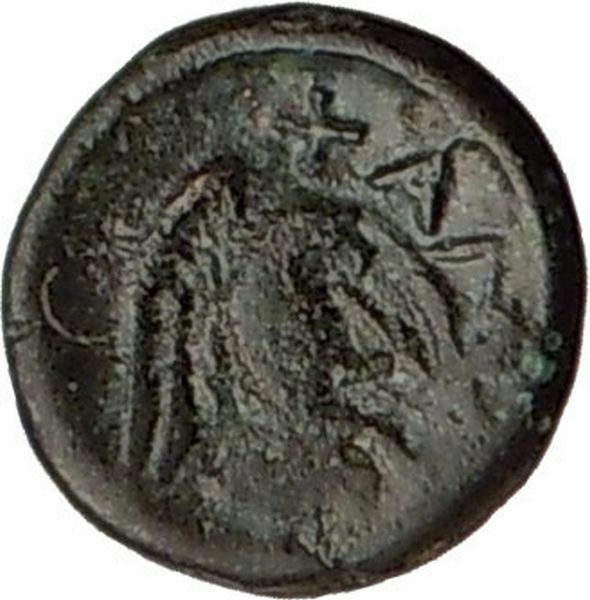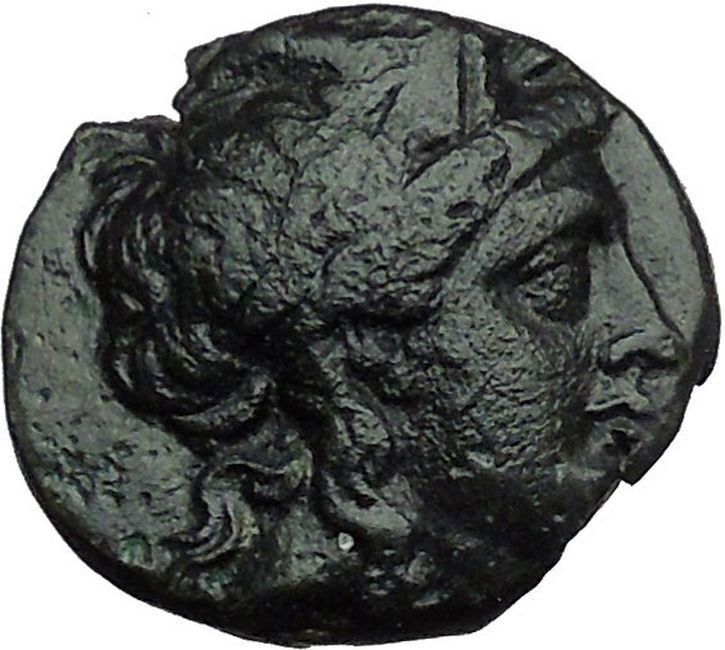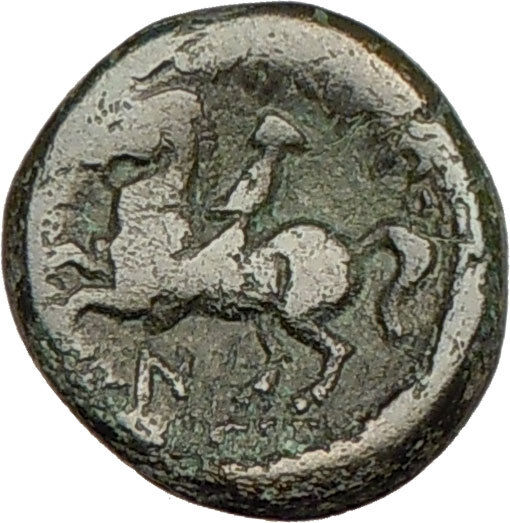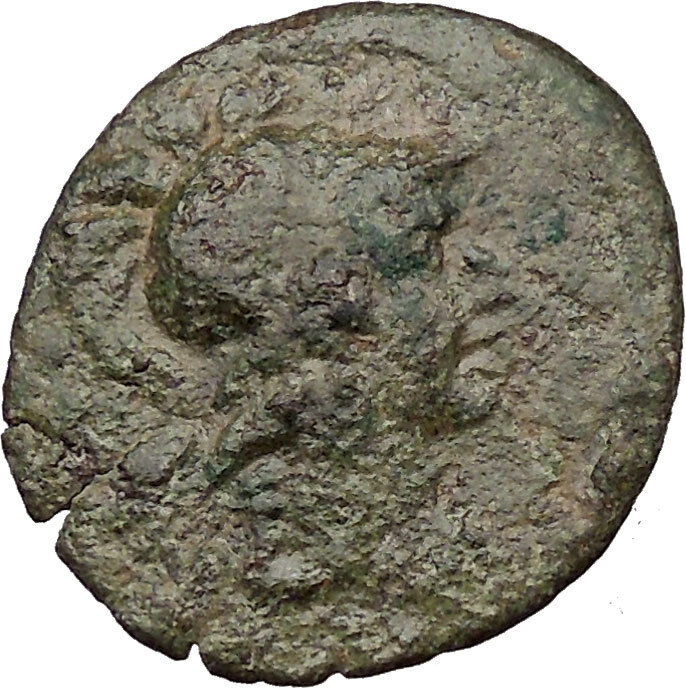|
Greek city of Ake-Ptolemais in Phoenicia
Bronze 16mm (4.01 grams) Struck circa 164-133 B.C.
Reference: HGC 10, 18; Sear 6046; Seyrig 3
Conjoined heads of the Dioscuri, laureate right.
ANTIOXEΩN TΩN / EN ΠTOΛEMAIΔI, Cornucopia.
At the northern end of the bay of Haifa, Ake was renamed Ptolemais in the early part of the 3rd century B.C., probably by Ptolemy II. From the time of Antiochos IV, 175-164 B.C., it bore the additional name of Antiocheia.
You are bidding on the exact item pictured, provided with a Certificate of Authenticity and Lifetime Guarantee of Authenticity.
 Gemini is one of the constellations of the zodiac. It was one of the 48 constellations described by the 2nd century AD astronomer Ptolemy and it remains one of the 88 modern constellations today. Its name is Latin for “twins,” and it is associated with the twins Castor and Pollux in Greek mythology. Its symbol is Gemini is one of the constellations of the zodiac. It was one of the 48 constellations described by the 2nd century AD astronomer Ptolemy and it remains one of the 88 modern constellations today. Its name is Latin for “twins,” and it is associated with the twins Castor and Pollux in Greek mythology. Its symbol is  (Unicode ♊). (Unicode ♊).
In Greek and Roman mythology, Castor and Pollux or Polydeuces were twin brothers, together known as the Dioskouri. Their mother was Leda, but Castor was the mortal son of Tyndareus, the king of Sparta, and Pollux the divine son of Zeus, who seduced Leda in the guise of a swan. Though accounts of their birth are varied, they are sometimes said to have been born from an egg, along with their twin sisters Helen of Troy and Clytemnestra.
In Latin the twins are also known as the Gemini or Castores. When Castor was killed, Pollux asked Zeus to let him share his own immortality with his twin to keep them together, and they were transformed into the constellation Gemini. The pair were regarded as the patrons of sailors, to whom they appeared as St. Elmo’s fire, and were also associated with horsemanship.
They are sometimes called the Tyndaridae or Tyndarids, later seen as a reference to their father and stepfather Tyndareus.
_-_Google_Art_Project.jpg/260px-Peter_Paul_Rubens_-_Abundance_(Abundantia)_-_Google_Art_Project.jpg) The cornucopia (from Latin cornu copiae) or horn of plenty is a symbol of abundance and nourishment, commonly a large horn-shaped container overflowing with produce, flowers or nuts. The horn originates from classical antiquity, it has continued as a symbol in Western art, and it is particularly associated with the Thanksgiving holiday in North America. The cornucopia (from Latin cornu copiae) or horn of plenty is a symbol of abundance and nourishment, commonly a large horn-shaped container overflowing with produce, flowers or nuts. The horn originates from classical antiquity, it has continued as a symbol in Western art, and it is particularly associated with the Thanksgiving holiday in North America.
Mythology offers multiple explanations of the origin of the cornucopia. One of the best-known involves the birth and nurturance of the infant Zeus, who had to be hidden from his devouring father Kronus. In a cave on Mount Ida on the island of Crete, baby Zeus was cared for and protected by a number of divine attendants, including the goat Amalthea (“Nourishing Goddess”), who fed him with her milk. The suckling future king of the gods had unusual abilities and strength, and in playing with his nursemaid accidentally broke off one of her horns, which then had the divine power to provide unending nourishment, as the foster mother had to the god.
In another myth, the cornucopia was created when Heracles (Roman Hercules) wrestled with the river god Achelous and wrenched off one of his horns; river gods were sometimes depicted as horned. This version is represented in the Achelous and Hercules mural painting by the American Regionalist artist Thomas Hart Benton.
The cornucopia became the attribute of several Greek and Roman deities, particularly those associated with the harvest, prosperity, or spiritual abundance, such as personifications of Earth (Gaia or Terra); the child Plutus, god of riches and son of the grain goddess Demeter; the nymph Maia; and Fortuna, the goddess of luck, who had the power to grant prosperity. In Roman Imperial cult, abstract Roman deities who fostered peace (pax Romana) and prosperity were also depicted with a cornucopia, including Abundantia, “Abundance” personified, and Annona, goddess of the grain supply to the city of Rome. Pluto, the classical ruler of the underworld in the mystery religions, was a giver of agricultural, mineral and spiritual wealth, and in art often holds a cornucopia to distinguish him from the gloomier Hades, who holds a drinking horn instead.
Ptolemais was an ancient port city on the Phoenician coast. It was also called Ptolemais in Phoenicia (or Akko, Ake or Akre in the Phoenician language). It was an Ancient bishopric, which became a double Catholic titular see.
In the Middle Ages, it was known as Acre amongst some Western European crusaders, who started a new, militantly Latin chapter there.
History
Greek historians refer to the city as Ake, meaning “cure.” According to the Greek myth, Heracles found curative herbs here to heal his wounds. Josephus calls it Akre. The name was changed to Antiochia Ptolemais (Ancient Greek: Αντιόχεια Πτολεμαίς) shortly after Alexander the Great’s conquest, and then to Ptolemais, probably by Ptolemy I Soter, after the Wars of the Diadochi lead to the partition of the kingdom of Alexander the Great and its inclusion first into the Egypt-based Lagid empire, then in the Seleucid Empire.
Around 37 BC, the Romans conquered the Hellenized Phoenician port-city called Akko. It became a colony in southern Roman Phoenicia, called Colonia Claudia Felix Ptolemais Garmanica Stabilis. Ptolemais stayed Roman for nearly seven centuries until 636 AD, when was conquered by the Muslim Arabs. Under Augustus, a “Gymnasium” was built in the city. In 4 BC, the Roman proconsul Publius Quinctilius Varus assembled his army there in order to suppress the revolts that broke out in the region following the death of Herod the Great.
The Romans built a breakwater and expanded the harbor at the present location of the harbor….In the Roman/Byzantine period, Acre-Ptolemais was an important port city. It minted its own coins, and its harbor was one of the main gates to the land. Through this port the Roman Legions came by ship to crush the Jewish revolt in 67AD. It also served was used as connections to the other ports (for example, Caesarea and Jaffa)….The port of Acre (Ptolemais) was a station on Paul’s naval travel, as described in Acts of the Gospels (21, 6-7): “And when we had taken our leave one of another, we took ship; and they returned home again. And when we had finished our course from Tyre, we came to Ptolemais, and saluted the brethren, and abode with them one day”.
During the rule of the emperor Claudius there was a building drive in Ptolemais and veterans of the legions settled here. The city was one of four colonies (with Berytus, Aelia Capitolina and Caesarea Maritima) created in ancient Levant by Roman emperors for veterans of their Roman legions. As a result, Claudius granted the title “Colonia Claudia Felix Ptolemais Garmanica Stabilis”. The city was a center of Romanization in the region, but most of the population was made of local Phoenicians and Jews: as a consequence after the Hadrian times the descendants of the initial Roman colonists were no more speaking Latin and were fully assimilated in less than two centuries (however the local society’s customs were Roman).
In 66 AD Gessius Florus, the Roman Procurator of Judea, conducted an initial massacre of the Jews living in the city. The next year Vespasian, the Roman military commander (soon to be emperor), accompanied by his son Titus, moved from Akko-Ptolemais to suppress the Jewish rebellion in Galilee.
In 130 AD the port of Ptolemais was used as a base for the Roman Legions setting forth to suppress the Bar-Kochba revolt. After the destruction of Jerusalem many Jews settled in Ptolemais, that was losing its original Phoenician characteristics since Augustus times.
In 190 AD Christianity started to be important in the city: Clarus, the Bishop of Ptolemais, participated in a council of Christian leaders. Ptolemais grew to be an important port in the eastern Mediterranean sea of the Roman empire. After Hadrian times Ptolemais was the commercial center & port of Jewish Galilea and was starting to be no more part of Phoenicia.
In 351 AD Constantius Gallus suppressed a Jewish rebellion and did a small massacre of the Jews of Akko-Ptolemais (who were starting to be the majority of the city’s population and rejected Roman domination).
Under Byzantine control the city lost importance and around 636 AD was conquered by the Arab Amr ibn al-Aas. Following the defeat of the Byzantine army of Heraclius by the Muslim army of Khalid ibn al-Walid in the Battle of Yarmouk, and the capitulation of the Christian city of Jerusalem to the Caliph Umar, Ptolemais was ruled by the Rashidun Caliphate beginning in 638 AD.
Christianity center
Ptolemais was an important center of early Christianity in the region. Saint Paul visited the city at the end of his third missionary journey.
Towards the end of the third century, Ptolemais was a predominantly Christian city, but with a large Jewish community. An unidentified visitor from Italy reported that in the sixth century the city had beautiful churches. Indeed, an important discovery was made in 2011: a Byzantine church in the middle of Crusaders’ “San Giovanni d’Acri” (as was called Ptolemais in the Middle Ages).
Ecclesiastical History
The Apostle Paul, returning from his trip to Macedonia and Achea, landed at Tyre, and from there sailed to Ptolemais, where he stayed some days with the local Christian community (acts 21.7).
Ptolemais became of suffragan of the Metropolitan Archbishopric of Tyre.
The first bishop known is Clarus, who in 190 AD attended a Council meeting which saw some bishops of Phoenicia and Palestine to deal with the issue of the date of the Easter feast. But we must go back to the fourth century to find the next Bishop, Enea, who took part at the first Council of Nicaea in 325 AD and at the Synod held in Antioch in 341 AD. Nectabus was one of the fathers of the first Ecumenical Council of Constantinople in 381 AD. Between the 4th and 5th centuries lived Bishop Antiochus, opponent of Giovanni Crisostomo. Elladius participated in the first Council of Ephesus in 431 AD. Paul took part in the Council held at Antioch of 445 AD to judge the work of Athanasius of Perre and at the Council of Chalcedon of 451 AD. In 518 AD Bishop Giovanni signed a Synodal letter against Severus of Antioch and the Monophysite party. Finally, the last known Bishop of Ptolemais is Giorgio, who attended the second Council of Constantinople in 553 AD.
It faded after Islam was established in Greater Syria in the 7th century by the first Caliphs, conquering the Sassanid satrapy. The Crusaders started all over in their Kingdom of Jerusalem, which wouldn’t last either, including a Latin Catholic Diocese of Acree.
|




 Gemini is one of the constellations of the zodiac. It was one of the 48 constellations described by the 2nd century AD astronomer Ptolemy and it remains one of the 88 modern constellations today. Its name is Latin for “twins,” and it is associated with the twins Castor and Pollux in Greek mythology. Its symbol is
Gemini is one of the constellations of the zodiac. It was one of the 48 constellations described by the 2nd century AD astronomer Ptolemy and it remains one of the 88 modern constellations today. Its name is Latin for “twins,” and it is associated with the twins Castor and Pollux in Greek mythology. Its symbol is  (Unicode ♊).
(Unicode ♊)._-_Google_Art_Project.jpg/260px-Peter_Paul_Rubens_-_Abundance_(Abundantia)_-_Google_Art_Project.jpg) The cornucopia (from Latin cornu copiae) or horn of plenty is a symbol of abundance and nourishment, commonly a large horn-shaped container overflowing with produce, flowers or nuts. The horn originates from classical antiquity, it has continued as a symbol in Western art, and it is particularly associated with the Thanksgiving holiday in North America.
The cornucopia (from Latin cornu copiae) or horn of plenty is a symbol of abundance and nourishment, commonly a large horn-shaped container overflowing with produce, flowers or nuts. The horn originates from classical antiquity, it has continued as a symbol in Western art, and it is particularly associated with the Thanksgiving holiday in North America.




